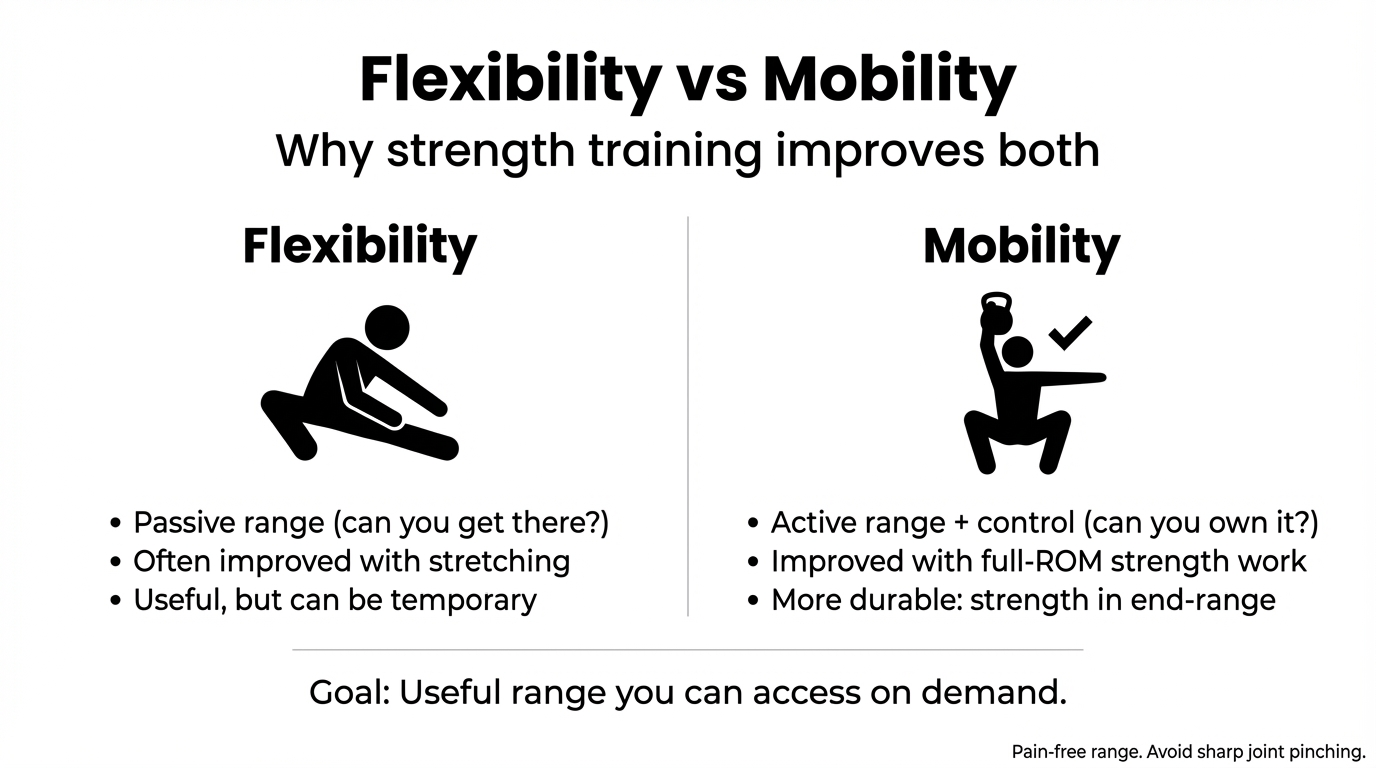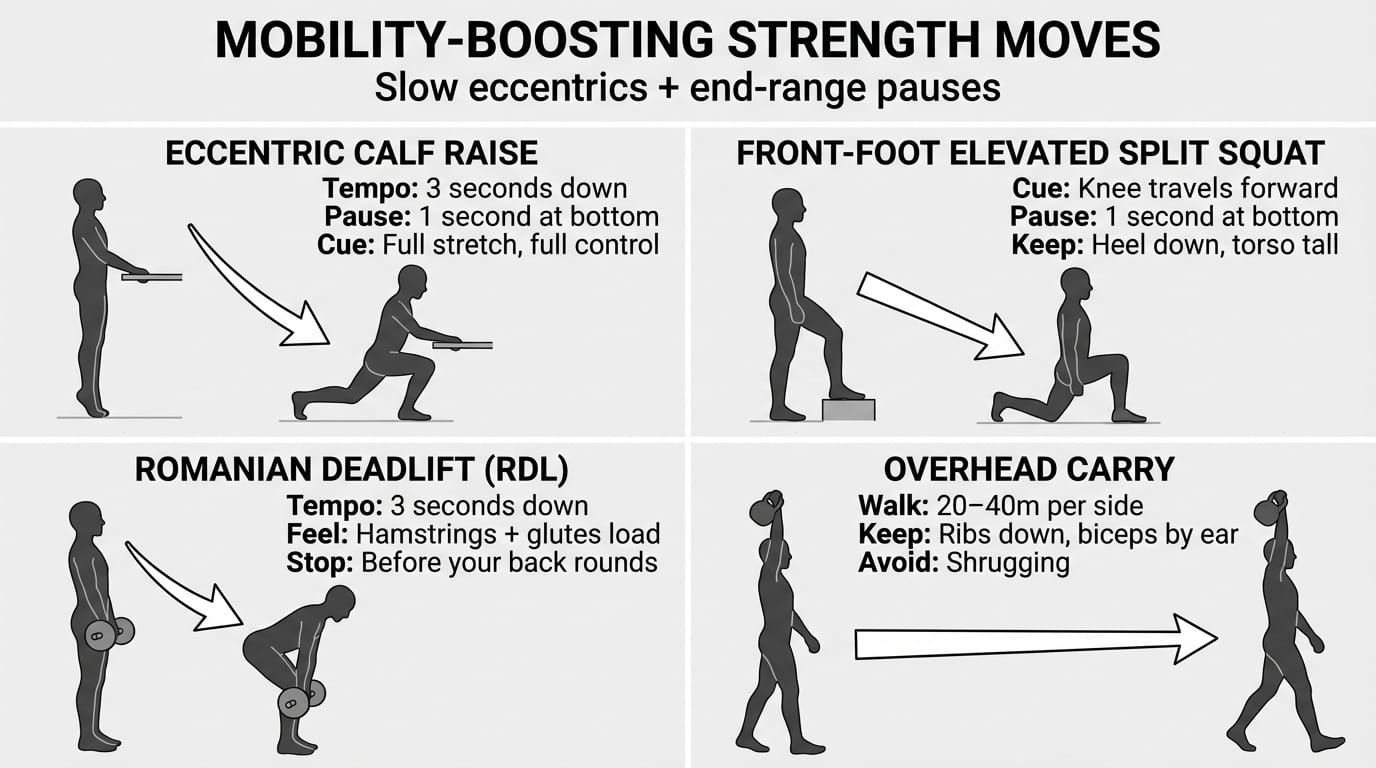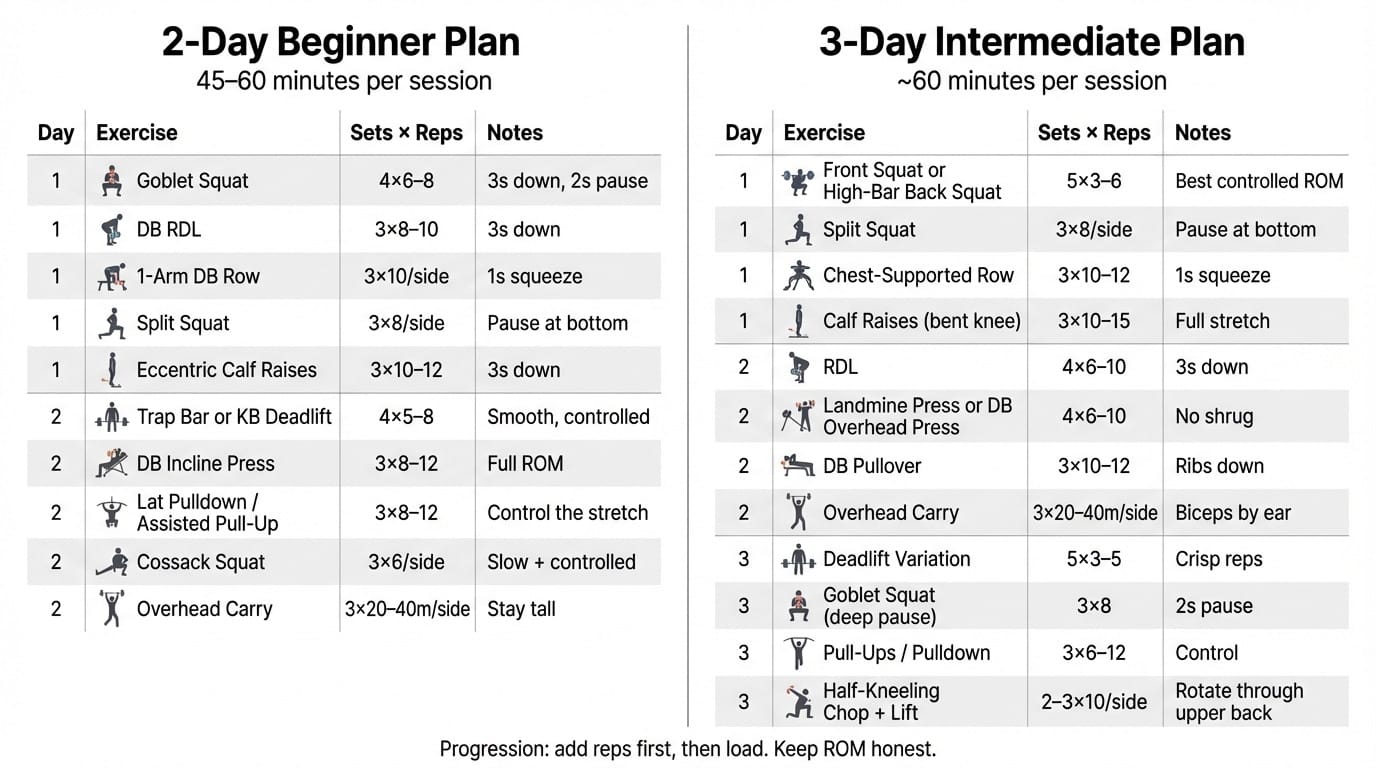Most people chase flexibility with more stretching. That can help — but there’s a faster, more “sticky” route: get strong in bigger ranges of motion.
When you lift through a full range of motion (ROM), you’re not just lengthening tissue — you’re teaching your nervous system that those positions are safe and controllable. That’s what turns “I can stretch into it” into “I can move into it.”
Table of contents
- Quick answer
- Flexibility vs mobility (and why you need both)
- How strength training improves ROM (the science, in plain English)
- The 4 rules that turn lifting into mobility work
- Best strength exercises for flexibility + mobility (by body area)
- 8-minute warm-up for better movement
- 2-day beginner plan (flexibility + mobility focused)
- 3-day intermediate plan (own deeper ranges)
- Common mistakes that keep you stiff
- FAQ
- Summary
Quick answer
If you want strength training to improve flexibility and mobility:
- Lift through the largest pain-free range you can control.
- Use slow eccentrics (3 seconds down) and pauses at end range (1–2 seconds).
- Train 2–3x/week, and add 5–10 minutes of targeted mobility most days.
- Pick 2–3 problem zones (commonly ankles, hips, thoracic spine, shoulders) and bias your exercise selection toward them.
Flexibility vs mobility (and why you need both)
These words get thrown around like they mean the same thing, but they don’t.
- Flexibility is your ability to move a joint or muscle through a range — often measured passively (e.g., can you pull your leg up further with your hands?).
- Mobility is your ability to move through that range actively, under your own control, without compensation (pinching, collapsing, rounding, shrugging).
You can be “flexible” on paper and still feel stiff in real life because you don’t have strength and control in the positions you’re trying to reach.
A simple example:
- If you can sit in a deep squat holding onto a pole, but you can’t squat deep under control, that’s usually a mobility (strength/control) problem more than a flexibility one.
How strength training improves ROM (the science, in plain English)
You don’t need to memorize studies to use the idea. Here’s what matters:
1) Full-ROM lifting acts like “loaded stretching”
When you squat deep, your hips and ankles are being stretched — but unlike passive stretching, you’re also building strength at that depth.
That combination is powerful because it improves:
- Tissue tolerance (stretch doesn’t feel as threatening)
- Strength in lengthened positions
- Coordination and control through the joint’s range
2) Slow eccentrics change what “tight” feels like
A lot of tightness is protective — your nervous system putting the brakes on because it doesn’t trust the end range.
Slow lowering (eccentrics) gives your body time under tension in the lengthened position and often improves both strength and range.
3) Strength at end-range makes flexibility “stick”
Many people can gain range temporarily from stretching, then lose it again.
Strength training tends to make range more durable because you’re building capacity in that ROM, not just borrowing it.
The 4 rules that turn lifting into mobility work
Rule 1: Use the most ROM you can control (pain-free)
“Full ROM” doesn’t mean forcing depth at all costs. It means:
- Go as deep as you can while maintaining good form
- Over weeks, gently expand the range as control improves
Rule 2: Slow eccentrics (3 seconds down)
Pick 1–2 main lifts per session and use:
- 3 seconds down
- normal speed up
This is simple, measurable, and effective.
Rule 3: Pause at end range (1–2 seconds)
Pauses build confidence and control where you’re normally weak.
Examples:
- Pause at the bottom of a squat
- Pause at the stretched position of an RDL
- Pause overhead in a carry
Rule 4: Add 1–2 “end-range accessories”
After your main lifts, add accessories that bias the limiting joint angle.
This is where you target ankles/hips/shoulders directly.
Best strength exercises for flexibility + mobility (by body area)

Pick the areas you actually need. Most people improve fast focusing on just two: ankles + hips, or hips + thoracic spine, etc.
Ankles (dorsiflexion: knees over toes)
Why it matters: Better squat depth, cleaner lunges, improved running mechanics, less achy knees.
1) Eccentric calf raises (straight knee + bent knee)
- 3 sets of 8–12 each
- 3 seconds down
- full stretch at bottom
- pause 1 second
2) Front-foot elevated split squat (knee travels forward)
- 3 sets of 8 each side
- slow and controlled
- pause at the bottom
3) Goblet squat pry (light load)
- 2 rounds of 30–45 seconds
- shift gently side-to-side, breathe
Hips (flexion + rotation)
Why it matters: Deep squat comfort, better hinges, less “stuck” hips, fewer compensations in the low back.
1) Goblet squat with deep pause
- 4 sets of 6–8
- 3 seconds down
- 2-second pause at the bottom
2) Cossack squat (bodyweight → goblet)
- 3 sets of 6–8 per side
- slow descent, controlled return
- keep heel down on the working leg
3) Romanian deadlift (RDL)
- 3 sets of 8–10
- 3 seconds down
- stop when you feel hamstrings + glutes loaded (don’t chase the floor)
Hamstrings (length + strength)
Why it matters: Touching toes without yanking, better hinge mechanics, fewer strains.
1) RDL (again — high ROI)
- 3–4 sets of 6–10
- controlled eccentric
2) Slider hamstring curls (towel on wood floor works)
- 3 sets of 6–10
- slow out, controlled back
3) Single-leg RDL (light DB)
- 3 sets of 8 per side
- focus on balance and hip control
Thoracic spine (upper-back mobility)
Why it matters: Better overhead position, less desk posture, smoother pressing.
1) Half-kneeling chop + lift (band or cable)
- 2–3 sets of 10 per side
- rotate through the upper back, not the low back
2) Chest-supported row (1-second squeeze)
- 3 sets of 10–12
- pause, feel the shoulder blades move
3) Landmine press (if available)
- 3 sets of 8 per side
- great bridge toward overhead comfort
Shoulders (overhead mobility + control)
Why it matters: Pressing without pinching, better posture, healthier training long-term.
1) Dumbbell incline press
- 3 sets of 8–12
- controlled depth, shoulder blades stable
2) Dumbbell pullover (light)
- 3 sets of 10–12
- ribs down, slow stretch
3) Overhead carry (KB/DB)
- 3 sets of 20–40m per side
- stay tall, don’t shrug
8-minute warm-up for better movement
Use this before lifting (or as a daily reset):
- 90/90 breathing (ribs down) — 60 seconds
- Cat-cow into thoracic reach — 6 reps per side
- Ankle rocks — 10 reps per side
- World’s greatest stretch (slow) — 5 reps per side
- Bodyweight squat with 2-second pause — 5 reps
Then do 2–4 warm-up sets for your first main lift.
2-day beginner plan (flexibility + mobility focused)
Frequency: 2 days/week
Session length: ~45–60 minutes
Progression: Add 1 rep each week until you hit the top of the rep range, then add a small amount of load.

Day 1
- Goblet squat (3s down, 2s pause) — 4×6–8
- DB RDL (3s down) — 3×8–10
- 1-arm DB row — 3×10 per side
- Split squat (front foot elevated if needed) — 3×8 per side
- Eccentric calf raises — 3×10–12
Day 2
- Trap bar deadlift or kettlebell deadlift — 4×5–8
- DB incline press — 3×8–12
- Lat pulldown / assisted pull-up — 3×8–12
- Cossack squat (bodyweight/light) — 3×6 per side
- Overhead carry — 3×20–40m per side
“Mobility snacks” (5–10 minutes, 4–6 days/week)
Choose one focus:
- Ankles: 2×10 ankle rocks + 2×10 calf raises (full ROM)
- Hips: 2×6 Cossacks/side + 1×45s deep squat hold
- Shoulders: 3×20m overhead carry/side
3-day intermediate plan (own deeper ranges)
Frequency: 3 days/week
Session length: ~60 minutes
Goal: Strength + control in deeper, cleaner positions.
Day 1 (Squat bias)
- Front squat or high-bar back squat — 5×3–6 (best ROM you can control)
- Split squat — 3×8 per side
- Chest-supported row (1s squeeze) — 3×10–12
- Calf raises (bent knee) — 3×10–15
Day 2 (Hinge + shoulder)
- RDL — 4×6–10 (3s down)
- Landmine press or DB overhead press — 4×6–10
- DB pullover — 3×10–12
- Overhead carry — 3×20–40m per side
Day 3 (Full body + rotation)
- Deadlift variation (trap bar preferred for many) — 5×3–5
- Goblet squat (deep pause) — 3×8
- Pull-ups / pulldown — 3×6–12
- Half-kneeling chop + lift — 2–3×10 per side
Common mistakes that keep you stiff
- Rushing reps (no eccentric, no pause)
- Only stretching what feels tight instead of strengthening what you can’t control
- Training partial ROM forever (especially squats + hinges)
- Chasing pain (pinchy joints aren’t a good sign)
- No plan (random sessions rarely fix persistent limitations)
FAQ
Will lifting weights make me less flexible?
Not if you train through a controlled ROM. Full-ROM resistance training can improve flexibility and mobility — often as well as stretching — while building strength and stability.
Do I still need stretching?
Many people do great with full-ROM lifting plus short daily mobility snacks. If a specific limitation won’t budge, add targeted stretching after training or on rest days.
How long until I notice improvement?
Most people feel a difference in 2–4 weeks with consistent full-ROM training. Bigger, longer-lasting changes come from months of building strength in the new range.
What if deep squats hurt my hips or back?
Change the variation:
- Try goblet squats, heel elevation, or a box target
- Reduce depth slightly and build it back over time
- If you get sharp joint pain or pinching, consider a professional assessment
Summary
Strength training can be one of the best ways to improve flexibility and mobility because it builds range + control.
Use the formula:
- Full ROM you can control
- Slow eccentrics
- End-range pauses
- A couple of targeted accessories
- Short mobility snacks most days















